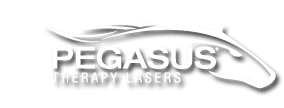Laser Basics
Terms in Laser Therapy:
LASER is an acronym that stands for Light Amplification by the Stimulated Emission of Radiation. Lasers emit light that is monochromatic (a single color or wavelength), coherent (in phase), and collimated.
Abbreviations:
ºC Degrees Celsius
A Amperes
mA Milliamp
Hz Hertz
AC Alternating current
cm Centimeter
mm Millimeter
nm Nanometer
μm Micrometers
CW Continuous Wave
PW Pulsed Wave
SP Super Pulsed
J Joule
W Watts
mW milliWatts
s Second
mS Millisecond
μs Microsecond
Fluence – a measure of instantaneous power output from the laser typically measured in Watts
Wavelength – length between two identical points on subsequent electromagnetic waves. The wavelength of a laser determines it’s color and absorption properties.
Irradiance – power per unit area at a treatment surface
Dosing – The most common dosing technique in laser therapy is the energy density delivered to the surface of the tissue which is typically expressed in J/cm2.
Laser Classifications
Lasers are divided into safety classifications in the US by the American National Standard Identification (ANSI) and globally by the International Electrotechnical Commission (IEC). The classifications below from the revised system (2002) apply to non-magnified laser devices.
Class I
Safe under all conditions of normal use.
Class II
Applies to only visible light lasers (400-700nm). These devices are considered eye-safe because the blink reflex will limit exposure to less than 0.25 seconds. Intentional suppression of the blink reflex could lead to eye injury. Most laser pointers are Class II devices.
Class III
Class III lasers in the visible spectrum have continuous wave (cw) emission of 5mw or less. These devices are considered safe if handled carefully with restricted beam viewing
Class IIIB
IIIB lasers are hazardous to the eye when viewed directly. For visible and infrared devices emission power is limited to 0.5W. Protective eyewear, key switch and safety interlock are required safety features.
Class IV
Class IV lasers include all lasers that emit power in excess of IIIB limitations. Eye protection is needed to limit both direct and diffuse reflected exposure. Key switch and safety interlocks are also required safety features. Most scientific, industrial, military and medical lasers fall into this category.
Resources and Links
American Physical Therapy Association (APTA):
“Clinicians should consider the use of low-level laser therapy to decrease pain and stiffness in patients with Achilles tendinopathy”
World Health Organization (WHO):
“Laser therapy is beneficial in treatment of neck pain”
International Association for the Study of Pain (IASP):
“Laser therapy shows strong evidence of effectiveness for pain relief”




